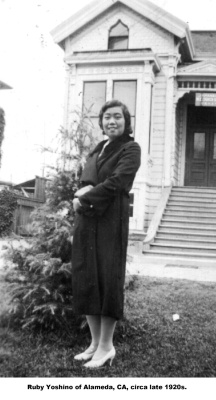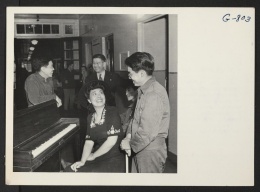Ruby Yoshino Schaar
| Name | Ruby Yoshino Schaar |
|---|---|
| Born | February 23 1913 |
| Died | August 15 1987 |
| Birth Location | Alameda, California |
| Generational Identifier |
Nisei soprano and community leader. A celebrated opera soprano, Ruby Yoshino was among the first Nisei to achieve national stardom as a singer, and later served as president of the New York City Japanese American Citizens League (JACL) chapter. [1]
Early Life
Born in Alameda , California, in 1913, Ruby was one of nine children of Yoshimatsu and Mitsuye Yoshino. Her eldest brother, John Y. Yoshino, would become a JACL leader and ultimately a longtime equal employment opportunity specialist for the federal government. Ruby Yoshino started out as a singer while at Alameda High School. Her music teacher, Hazel Hunter, introduced her to David Carlyes, a representative of the Pacific Coast Opera Company. She would later be accepted as a pupil by Piedmont voice teacher Lena Caroll Nicholson.
With help from an introduction by her father, she played her first major concert in 1931, aged 18, before an audience of 2,000 at the California Teacher's Institute in Oakland. The concert helped jumpstart Yoshino's local career as a singer, and led to a variety of appearances, often with patronage from women's clubs or organizations. The following year, she played a free lobby concert at Oakland YWCA, sang at an "International Concert Tea" at the Hotel Leamington produced by Matinee Musical Society, and appeared at a benefit tea for the Piedmont Children's Hospital. In 1935, Yoshino appeared in a concert before an audience of 400 at the UC Berkeley International House, presenting an aria from Puccini's opera Tosca . In a review of the concert, the Nichi Bei Shimbun praised her as a "nisei songbird." Her brother John worked as her manager during the early years of her career. [2]
In January 1936, Yoshino received an invitation to sing on radio for local CBS affiliates in San Francisco. The success of her performance led to the recording being broadcast nationwide. That summer, she reached the semifinals of the Oakland Tribune-California State Fair amateur contest. In September 1936, Yoshino sang at the Northern Democratic Conference's Oakland picnic as part of a fundraiser for President Roosevelt's reelection campaign. It was followed by an invitation to appear at the Hotel Oakland in January 1937 at one of the "Birthday Balls" organized under Roosevelt's aegis by the March of Dimes as a fundraiser for polio research. In her performance at the ball, Yoshino was accompanied by the great musician Duke Ellington, whose band was headlining the event. [3]
In addition to her concert repertoire, Yoshino distinguished herself as an "inspirational singer" performing at churches such as the Berkeley United Methodist Church, and in tours under the auspices of the Epworth League. Beginning in 1936, Yoshino was engaged on an approximately monthly basis to sing at church services at the Unity Wayside Center in Oakland—a rare mainstream gig for a Nisei singer.
Operatic Career
In September 1938, Yoshino enrolled as an undergraduate at UC Berkeley. While at Berkeley, she studied foreign languages to help with her singing career. A few months later, in January 1939, she traveled to New York. [4] According to one source she intended to audition for the famed Julliard school. Either she decided in the end not to audition or was not accepted. While in New York, she appeared on the nationally-broadcast radio program Major Bowes Amateur Hour . Yoshino sang "Una voce poco fa" from Rossini's The Barber of Seville , and was warmly praised by the host. She studied for a time with Charles Hackett, former tenor at the Metropolitan Opera.
In part due to her successful radio appearance, Yoshino grew more active on the West Coast. In December 1939, she made her San Francisco debut, performing at War Memorial Veterans Auditorium. [5] In February 1940, she undertook a Spring recital tour with performances in Fresno, Berkeley, and Palo Alto. In August 1940, she sang at the Greek Theater at UC Berkeley before an estimated audience of 500. In January 1941, she gave a recital at Berkeley Music Center. That year she launched a goodwill recital tour of eight California cities, under the auspices of the Methodist Board of Missions. In November 1941, she sang Mozart's "Allelulia" at Stanford University's Memorial Church.
In the October 1940 issue of James Omura 's Current Life magazine, JACL historian Teiko Ishida profiled Yoshino's accomplishments as the first successful Nisei singer. Omura, who was personally close to the Yoshino family, selected Ruby as part of a series on Nisei musicians and performers. Ishida praised Yoshino as a talented and dedicated singer who earned her success through hard work. Ishida highlighted that while Yoshino enjoyed celebrity status, she remained humble and sympathetic to others; for example, Ishida pointed out that Yoshino returned to her family home on weekends to do housekeeping and cooking for her family. [6]
Like other Nisei artists, Yoshino was forced to deal with being exoticized as Japanese. On the one hand, Yoshino often appeared onstage in a kimono, and agreed to perform as part of "international night" events. Her programs included songs by modern Japanese composers, notably Koscak Yamada and Kishi Yasuichi. Nonetheless, her repertoire consisted mostly of selections from classical European composers, including operatic arias by Rossini, Verdi and others, plus lieder. Unlike other Nikkei sopranos, for whom Cio-Cio-San in Puccini's "Japanese" opera Madama Butterfly was their "bread-and-butter" role, Yoshino never sang the role onstage, though she occasionally performed the aria "un bel di" in costume, such as at a "Professional Tryout Night" in Oakland in January 1936. She seems not to have auditioned to perform in the annual West Coast touring productions of Madama Butterfly , starring soprano Hizi Koyke, that the San Carlo Opera Company put on during these years.
Wartime Work
While Yoshino's career was slowly rising, world events largely put a stop to her performances. On December 7, 1941, she was scheduled to sing at an international fellowship at Oakland's First Methodist Church. It would be her last West Coast appearance. Shortly after, as a result of the incarceration of Japanese Americans under Executive Order 9066 , Yoshino's family was sent to Tanforan detention center before ending up at the Topaz Concentration Camp in Utah. Ruby escaped incarceration by moving to Denver , where she worked in a cleaning establishment—a photo of her working in the shop was used by the War Relocation Authority (WRA) as part of their resettlement program. She sang occasionally before church and club groups. In July 1944, she traveled to the camp at Amache and performed a concert for the inmates in the camp high school building.
In August 1944, Ruby Yoshino was offered the opportunity to make an East Coast publicity tour for the JACL to promote understanding of Japanese Americans and build support for resettlement from camp. The tours, orchestrated by JACL leader Dr. Thomas T. Yatabe of the Chicago JACL, were sponsored by the JACL and the WRA. The tour was one of several JACL campaigns organized to boost the image of Japanese Americans throughout the United States and support resettlement initiatives, with local resettlement committees sponsoring Yoshino's performances. Yoshino presented concerts in areas throughout the Midwest and East Coast, making stops in Chicago, Rochester, New England, and Washington, D.C.. On one occasion, Yoshino sang before wounded soldiers at Walter Reed Army Hospital, with a photo of her performance appearing in a JACL pamphlet on the Nisei contributions to the war effort. In January 1945, Yoshino returned to New York to sing for a fundraiser for the Japanese American Committee of New York. [7]
Postwar Life and Work for the New York JACL
After the end of the war, Ruby Yoshino settled in New York City and resumed her singing career. In 1948, Yoshino helped form the One World Ensemble, an interracial "quartette" dedicated to showing that music "is beyond racial and nationality barriers." Napoleon Reed, an African American tenor, was a member of the ensemble. As with Yoshino's previous solo repertoire, the quartet sang operatic arias from composers such as Mozart, along with songs from Japan and other countries. The group toured in New York and Chicago for a year, and was managed by Columbia Artists.
She soon married pianist Rudolf Schaar, performing alongside him at recitals. In December 1950, she made her formal New York concert debut at Times Hall. She sang a number of Japanese songs as well as a Beethoven aria and a group of songs by contemporary American composers. A New York Times critic remarked, "Miss Yoshino sang everything loudly and in a metallic tone that soon palled. There were a few relaxed notes which gave an inkling of her true beauty of voice, however." [8] Shortly afterwards, she played a sold-out concert at Kimball Hall in Chicago. In September 1951, she sang at the Brooklyn Museum of Art, a concert broadcast over radio station WNYC. In May 1953, she did a recital at the Community Church of New York. She additionally began work as a vocal instructor for celebrities, counseling famed actors such as Anne Bancroft, Joan Crawford, and Don Ameche.
In addition to her singing career, Ruby Yoshino also established herself as a JACL leader. During the early 1950s, Yoshino lobbied for the right of Japanese immigrants to naturalize, which was granted by the McCarran Walter Act of 1952 . Yoshino ultimately served as president of the New York JACL chapter in the 1970s, and as a board member of the JACL newspaper Pacific Citizen from 1974 until 1980. In April 1984, Judge William Marutani honored Ruby in his column for the Pacific Citizen , declaring that she ranked among the JACL's greatest supporters alongside Mike Masaoka and Saburo Kido . That same year, Ruby created a scholarship with the New York City JACL that encourages playwrights to write about the Japanese American experience. Ruby personally contributed $5000 to the scholarship, and in recognition of her support the New York City JACL named it the Ruby Yoshino Schaar Biennium Playwright Award. [9] Winners of the award include Akemi Kikumura-Yano, Rick Shiomi, and Lane Nishikawa. On August 26, 1987, Ruby Yoshino Schaar died after a yearlong battle with cancer.
For More Information
Robinson, Greg, and Jonathan van Harmelen. "The Great Unknown and the Unknown Great: Japanese American singer and civil rights activist Ruby Hideko Yoshino." Nichi Bei Weekly , November 5, 2020.
Footnotes
- ↑ A previous version of this article appeared in the Nichi Bei Weekly : Greg Robinson and Jonathan van Harmelen, "The Great Unknown and the Unknown Great: Japanese American singer and civil rights activist Ruby Hideko Yoshino," Nichi Bei Weekly , Nov. 5, 2020.
- ↑ "Nisei Songbird Will Appear on Campus Program," Nichi Bei Shimbun , Oct. 20, 1935.
- ↑ "Nisei Songbird has Duke Ellington as Accompanist," Nichi Bei Shimbun , Feb. 2, 1937.
- ↑ "Ruby Yoshino Departs," Shin Sekai Asahi Shinbun , Jan. 7, 1939.
- ↑ "Ruby Yoshino Will Be Guest Singer," San Francisco Examiner , Nov. 26, 1939.
- ↑ Teiko Ishida, "She Sings To Fame," Current Life , Oct. 1940.
- ↑ "U.S.-Japanese Aid War Fund," New York Herald Tribune , Jan. 7, 1945.
- ↑ "Ruby Yoshino Sings Times Hall Program," The New York Times , Dec. 12, 1950.
- ↑ Bill Marutani, "One from the Heart: No. 2," Pacific Citizen , Apr. 27, 1984.
Last updated Jan. 16, 2024, 3:48 a.m..

 Media
Media
